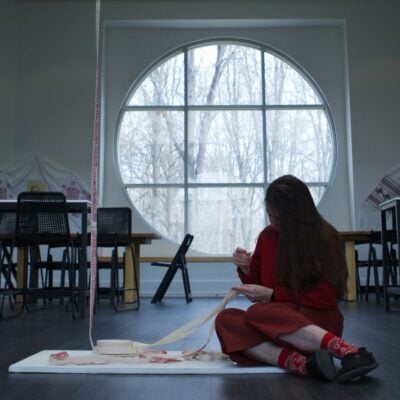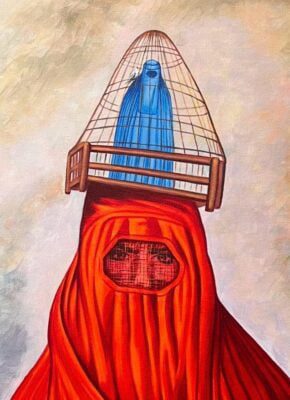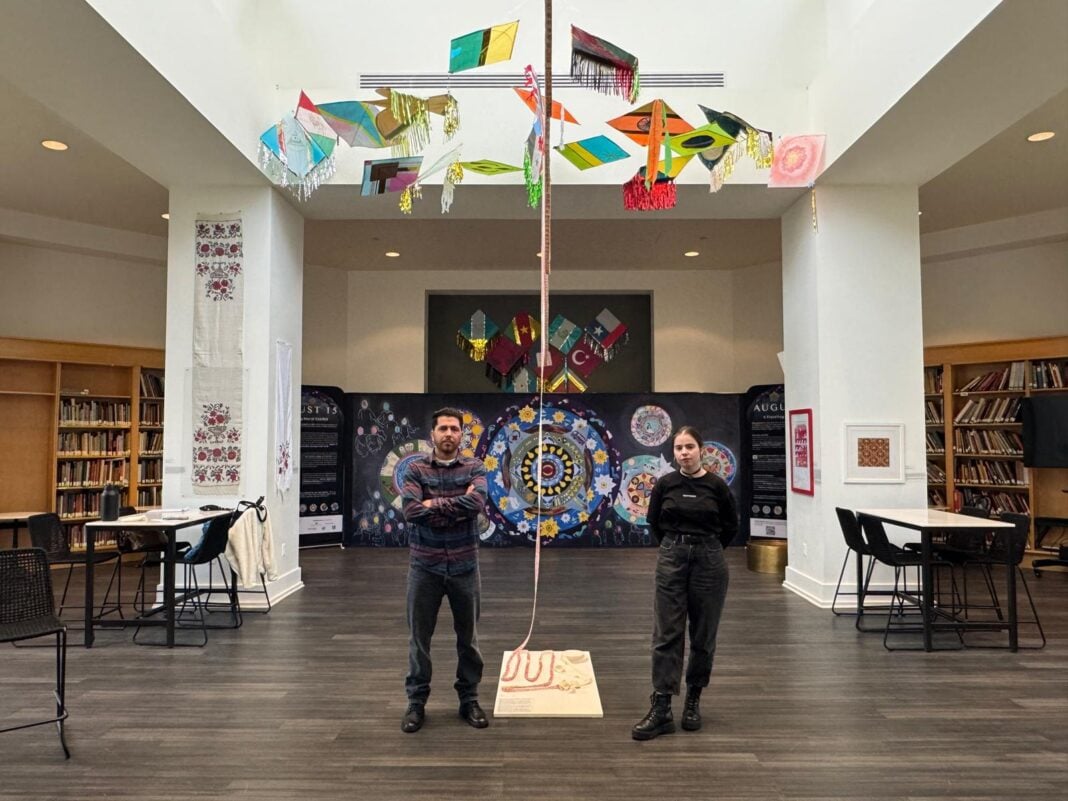Indy Art Center welcomes a new intercultural art exhibition about resilience this spring.
Indy Art Center is joining Patchwork Indy in collaboration with the Afghan American Community Center and the Ukrainian Society of Indiana to host “Resistance to Cruelty that Never Ends.” The exhibition, which is on display now through May 23 and features works by Ukrainian multimedia artist Iryna Bondar and Afghan oil painter Abdul Qahar Behzad, will have an opening reception from 5-8 p.m. on April 11 at the Indy Art Center.
“The artists we work with do not exist in a vacuum here in Indianapolis,” Bruce Garrison, CEO of Patchwork Indy, said in a statement. “There are thousands of Afghans and Ukrainians in Indiana who are our neighbors, and they bring their stories, their cultures and their considerable talents with them. This exhibition highlights those aspects and celebrates them.”
“Resistance to Cruelty that Never Ends” combines compelling visual narratives from Bondar and Behzad’s cultures — deeply affected by war, colonization and resilience. The exhibition blends contemporary illustration, hand-crafted kites, traditional Ukrainian embroidery, paintings and the traveling mural for Afghanistan.

Born and raised in Izmail, Ukraine, Bondar said she’s always been interested in art. She attended an art school in Ukraine at age 7 before moving to Indianapolis in 2015, where she attended Herron School of Art & Design.
When the full-scale invasion started in 2022, Bondar said she did not know what to do.
“I didn’t really make art,” she said. “I kind of took a long hiatus because it felt like it was the most useless thing that I could do while I saw my friends and family actually going to the front line or volunteering.”
However, Bondar started volunteering in any way she could, which included working on Support Ukrainian Artists, where she helped collect contact information of more than 700 artists from Ukraine and connect them to art buyers abroad. More than 50% of Ukrainians lost their jobs in 2022, and Bondar said this helped them continue to support their families.
Eventually, Bondar turned to art preservation, which inspired the work displayed in the exhibition.
“A lot of Ukrainians have been constantly deported, moved around,” Bondar said. “People forget or are afraid of telling their children their own history. … Once I started digging deeper and finding crumbs of information here and there, I turned into making this artwork, which is basically inspired by the folk artwork that people in Ukraine would do in their spare time.”
Bondar’s work features Rushnyk — a traditional piece of Ukrainian decor and ceremonial artifact — and reflects decolonization and the ongoing invasion of Ukraine. Rushnyk is a ritual towel, like a table runner with embroidery on both sides, Bondar said.
READ MORE: Community input requested for Tamika Catchings’ Mural
The styles of embroidery differ in style, color and technique depending on the region or village someone is from. Black and red became a Ukrainian trademark, and patterns would often be printed as well, as cross stitch was not part of Ukrainian iconography.
“Not a lot of things have survived, unfortunately, so things that I collect are usually either from where I’m from or from other areas of Ukraine,” Bondar said. “They inspired me to start kind of reproducing that folk art style, but with the modern narratives, especially narratives specifically about war, about my own heritage, and confronting the biases that Russian Empire has fed us throughout history and making sense of what actually was part of my history.”
One of Bondar’s embroidery pieces details the events of the Kakhovka Dam explosion by Russian forces, which took the lives of a suspected 200-300 people in June 2023, according to AP News.
“I think about that almost every single day,” Bondar said. “The fact that it was the largest manmade ecological catastrophe since Chernobyl in Europe, and it makes my blood boil the fact that all I can do is make an art piece about it and put it in a gallery and tell people about it.”
As part of the exhibition, Bondar walks to Indy Art Center every day at 12:30 p.m. to embroider the current number of days since the beginning of Russia’s full-scale invasion of Ukraine.
On the other side of the exhibition, Behzad’s oil paintings tell the story of Afghanistan and its millennia-old history, culture and resilience alongside current struggles with the Taliban regime.

Behzad, a self-taught oil painter, said he had to flee his home country with his family in 1996 when the Taliban took over. His parents, a librarian and an attorney, moved the family around to Iran and Pakistan, where they opened a small library.
As immigrants, Behzad said they did not have access to schooling, and for several years, he worked alongside his parents in the library where his fascination for art started to grow. Behzad started drawing around age 6 or 7 before moving on to watercolors, acrylics and oil paint.
“I wanted to create oil pieces because my country is very beautiful and very colorful and I needed something stronger that could basically reveal it, and watercolor and pencil drawing was not enough,” Behzad said. “Where I come from, my country is very rich with so much diversity, cultures and history. It’s very difficult to not create art pieces for your own people.”
The exhibition not only highlights the beauty of Afghanistan but also shines a light on the country’s current struggles, both educating and inspiring the next generation.
Behzad worked as an interpreter and art exhibitor and instructor for the U.S. military for more than 10 years before relocating to Indiana in August 2021 during the evacuation of Afghanistan. In recent years, he said the Taliban regime have “taken away everything from people,” including their freedom, lives, work, education and art.
“I’m trying to show that despite what’s happening around the world, we are neighbors,” Behzad said. “We are family, and we want to bring unity and art at the same time.”
“Resistance to Cruelty that Never Ends” and its opening reception are free to attend, and the artwork will be available to purchase. Following the exhibition, Indy Art Center will host supplemental programming, including an Afghan Community Conversation from 2-4 p.m. on April 27 and a Ukrainian Community Conversation from 6-8 p.m. on May 8. An Artist Talk with Bondar and Behzad is also scheduled to be determined.
Indy Art Center is always free and open to the public from 9 a.m. to 10 p.m., seven days a week. For more information about Indy Art Center or the exhibition, visit indyartcenter.org/exhibitions.
Contact Arts & Culture Reporter Chloe McGowan at 317-762-7848. Follow her on X @chloe_mcgowanxx.
Chloe McGowan is the Arts & Culture Reporter for the Indianapolis Recorder Newspaper. Originally from Columbus, OH, Chloe has a bachelor's in journalism from The Ohio State University. She is a former IndyStar Pulliam Fellow, and has previously worked for Indy Maven, The Lantern, and CityScene Media Group. In her free time, Chloe enjoys live theatre, reading, baking and keeping her plants alive.






Thank you for writing about this!
Comments are closed.